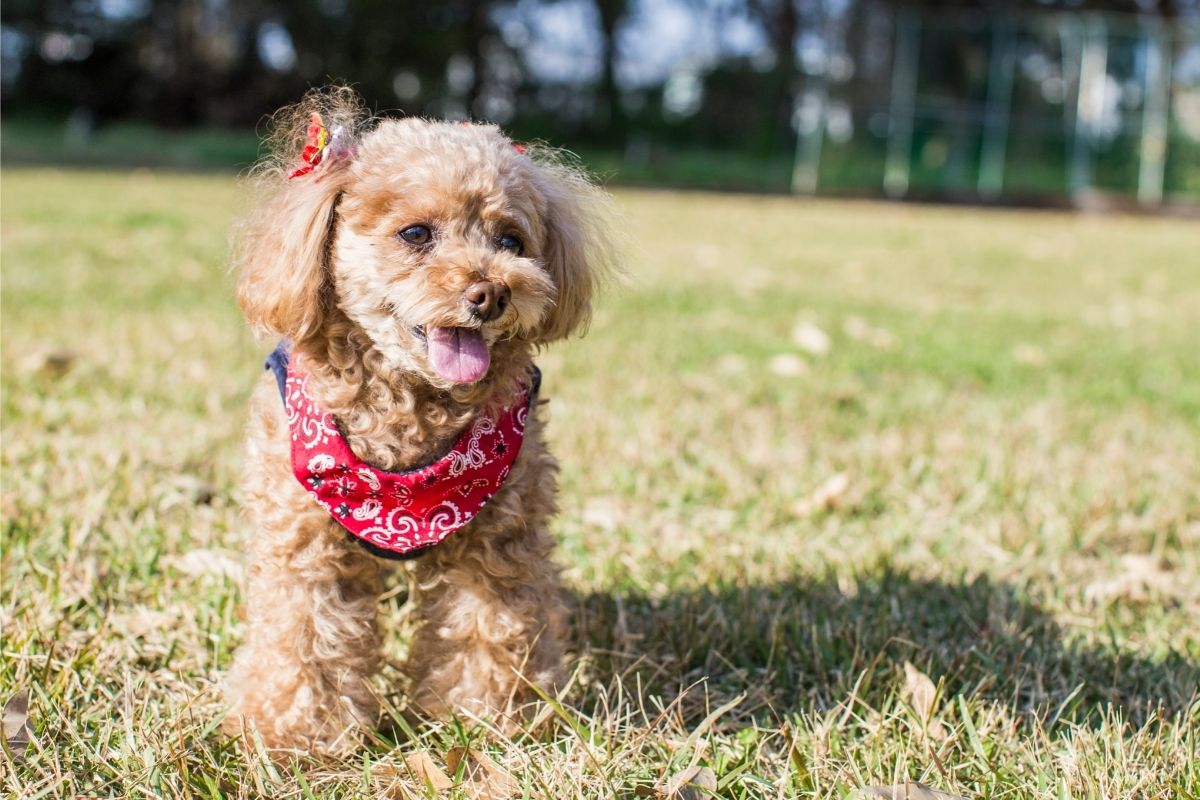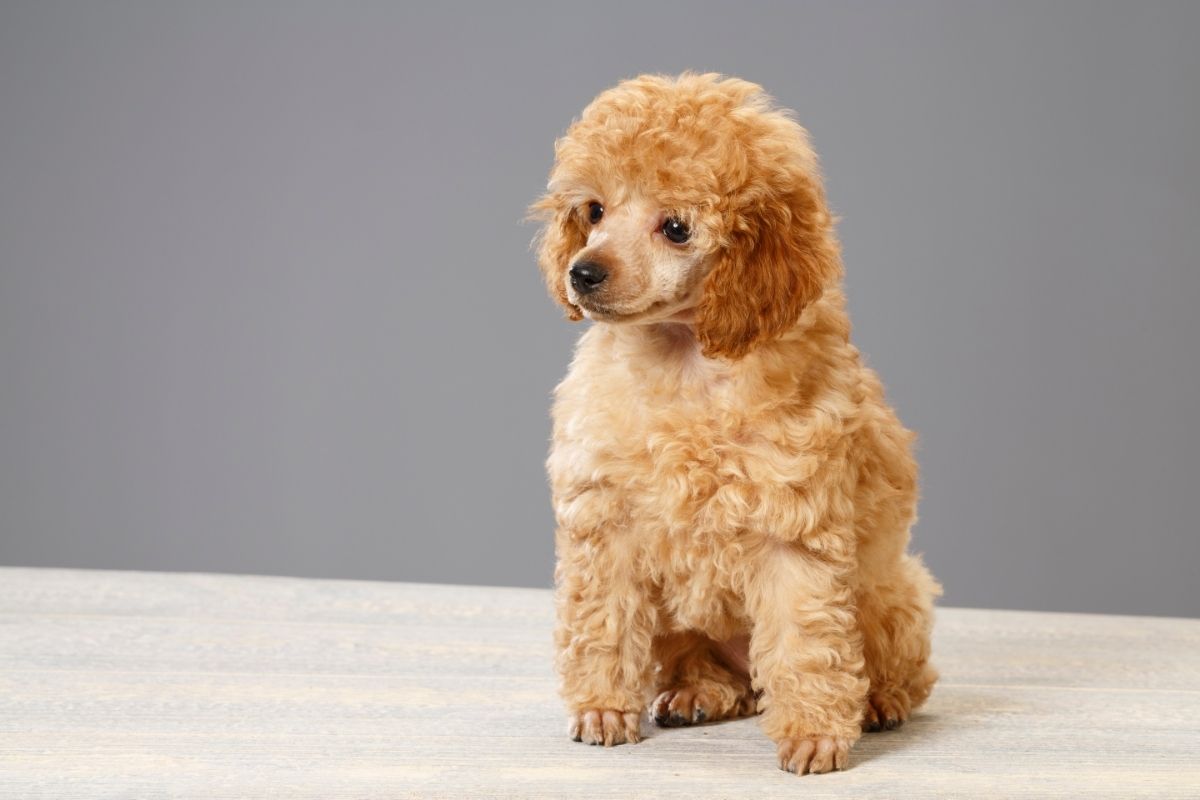The Full Grown Teacup Poodle Breed
What’s the one thing that strikes your mind when mentioning the word ‘teacup’? It must be something to do with the small size. Then you wonder what the full-grown Teacup poodle size is?
Known for its cuteness and adorable character, a Teacup poodle is one of the most beloved dog breeds for pet purposes. We will look at the different aspects of this great furball and why you need to own one.

What is the Size of a Fully Grown Teacup Poodle?
A typically fully grown Teacup poodle attains 6-8 in (15-20 cm) and between 2-5 lb (1.2-2 kg). They grow pretty fast. By the time they turn eight months, they have attained their height and continue to put on weight until 18 months of age. As you had rightly guessed, it is pretty petite.
We will look at the Teacup poodle vs. other poodle size comparison to fully understand its size.
Let us compare their average sizes to see this more clearly:
| Poodle Size Classification | Average Height Range (in) | Average Height Range (cm) | Average Weight Range (lb) | Average Weight Range (kg) |
| Teacup poodle | 6- 8 | 15-20 | 2-6 | 1-3 |
| Toy poodle | 8-10 | 20-25 | 6-8 | 3-4 |
| Miniature poodle | 10-15 | 25-38 | 10-15 | 5-7 |
| Standard poodle | 13-17 | 33-43 | 10-15 | 5-7 |
Note that only three sizes of poodle are recognized by the various kennel clubs globally.
Some of the clubs include the TKC (The Kennel Club) in the UK, AKC (American Kennel Club) in the US, and the ANKC (Australian National Kennel Council) in Australia.
Where Can I Find Full Grown Teacup Poodles for Sale?
Knowing where to get a full-grown Teacup poodle for sale is as important as knowing how much it will cost. The cost of a Teacup poodle is between $2000 to $5000. These miniature Teacup poodles are expensive because they are demanding to breed.
However, maintaining a Teacup poodle per month is less than the initial purchase cost. It is important to note that dogs are different, so are their owners. The price will vary depending on the food you purchase and medical expenses.
Some unscrupulous breeders know that this dog can fetch top dollar. So they use unethical breeding methods by breeding closely related animals or runts or starving the dog to stunt its growth. You need to be on the look for such sellers by getting the correct information about where to buy them.
Organizations like the American Kennel Club are the best places to start when finding a reputable breeder. However, the Teacup poodle does not meet the set standard guidelines for recognition by the AKC.
Before settling for a breeder, you need to research your options thoroughly. One of the best resources at your reach is the Regional Poodle Club. Identify some of the members of these local breed-specific organizations clubs and reach out to them through social media or face-to-face to know about their experience with those Teacup poodle breeders.
In these breed-specific organizations clubs, you will likely find a full-grown white Teacup poodle, Teacup red poodle, or puppies, among other varieties that might interest you.
If you find the Teacup poodle too expensive, you can consider getting one from your local shelter that needs a home.
What is a Teacup Poodle?
A teacup poodle breed is the smallest variation of the poodle. It’s a tiny Toy poodle. It is categorized as the unofficial category of the poodle because it does not qualify to be registered by the AKC.
Among those that AKC does not recognize is the Teacup Pomeranian. A white Teacup full-grown Pomeranian poodle, for instance, weighs 3-7 lbs (1-3 kg). Its demand has increased because of the need to keep smaller dogs as pets.
You might have heard of this tiny poodle, but did you know that this breed is also called a Barbone, a Puddle, Caniche, and a Chien Canne. One crucial fact is that these dogs are born in one or two litters, although they can be more occasionally.
Some dog owners choose to dock their tails either halfway or fully. This practice is in the USA, but it’s considered unethical in the UK.
Teacup Poodle Breed Information
A teacup poodle is a variation of the poodle, and it’s the smallest breed and very intelligent. The AKC does not recognize the Teacup poodle as a breed to the toy poodle, but the Dog Registry of America Inc acknowledges it as a breed in its rights.
In 1887 the poodle became an official American Kennel Club registered breed. Today, it is ranked as the seventh most popular dog nationwide. It is in three sizes: Toy, Miniature, and Standard.
Several Micro poodle breeds would interest you as a tiny canine lover. They include Pomeranian, poodle, Beagle, Maltese, and Pomsky. They also come in color varieties. For instance, you’ll find a red Teacup poodle, white Teacup poodle, brown Teacup poodle
What You Need to Know About Teacup Poodle Puppies
A Teacup poodle puppy is the closest pet you can have to a walking-breathing teddy bear. The grooming of their fury corded coats meets the owner’s standard, and their small size makes for that.
The greatest thing about these puppies is that they stay tiny. A Teacup poodle weighs 2 lbs (1kg) and can only reach 5 lbs (2 kg) at birth. These micro Teacup poodles have similar proportions to the larger ones.
This dog has a litter size of 1 or 2 puppies. The litter size rarely goes beyond puppies, but it’s not impossible.
The small size of these pups that make them adorable and cuddly is a disadvantage to their health. Their tiny size makes them susceptible to many diseases. You need to keep an eye on them constantly so they don’t get hurt while jumping from furniture to furniture or climbing stairs.
Some health issues have arisen because of loosening their breeding restrictions. Some of the health problems include:
Hip and Elbow Dysplasia
Due to their small size, this condition is quite common. The little pups’ joints become unstable, making the puppy feel so much pain. This condition can be hereditary, but being overweight also contributes.
You can see symptoms of this condition in their early stages (as early as five months,) though at this point, they are very subtle, and they become prominent as they advance in age. They include weak limbs, hopping with both rear legs, difficulty getting up off the floor, hesitant steps, and unwillingness to exercise, climb stairs, or play.
Patella Luxation
Also known as slipped Kkeecaps, these Teacup poodle puppies like to pull dangerous stunts that easily injure their breakable bones. Watch out for your pup when jumping off the couch.
Epilepsy
This condition is common to these Miniature poodles. This condition will make them show a combination of the following signs: drooling, unresponsiveness, pacing, stiff limbs, confusion, sudden unconsciousness, stiff limbs, difficulty breathing, among others.
Make sure you record all the symptoms that your Mini poodle is experiencing to help the veterinarian diagnose the severity of this condition.
Progressive Retinal Atrophy
Progressive retinal atrophy is a severe condition that can cause blindness. It tampers with the retina of both eyes and, in most cases, simultaneously. It is prudent to have this condition diagnosed early enough. Some of the symptoms include night vision problems, dilated pupils, bumping into furniture, glassy eyes, or other signs of canine blindness.
Addison’s Disease
It is a condition that makes your Tiny poodle lethargic, pressed, anxious, or have digestive problems. The adrenal glands, in this case, are not producing enough cortisol hormone. Acute Addison’s Disease in your teacup poodle will cause hospitalization.
Thyroid Issues
This condition in Teacup poodle results from inadequate levels of thyroid hormones. Some symptoms include hair loss, weak immune system, weight gain, excessive hunger, and looking out for warm spaces.
Hypoglycemia in Puppies
Hypoglycemia is a common condition in Teacup poodle puppies. It happens when blood sugar levels drop below the optimum level. When your pup has not eaten enough food regularly or has high-stress levels, their blood sugars drop. Miniature poodles puppies are prone to getting hypoglycemia within four months of birth.
Some of the symptoms of hypoglycemia may include weakness, confusion, clumsiness, shaking, tripping or falling, head tremors, shivering, or slowed breathing. It can lead to a coma if not treated early enough.
Teacup poodles love to take naps during the day. This symptom of hypoglycemia should not alarm you. However, if you notice two or three more symptoms, consult your veterinarian as soon as possible.
Sebaceous Adenitis
Teacup poodles can get a skin problem called sebaceous adenitis. This condition results from inflammation of the sebaceous glands leading to dog hair loss. Sebaceous adenitis can be diagnosed with a skin biopsy.

The Teacup Poodle Temperament
Teacup poodles are smart, active, agile, easy to train, eager to learn, outgoing, and people-pleasers.
Are you looking for a cuddly and playful dog? A Teacup poodle is great. This Tiny poodle will run around you from couch to floor to catch your attention, making the Teacup poodle a very loyal companion. Watch out for rough play, leading to unprecedented injuries (internal or external).
Their love for attention makes these charming pups suffer separation anxiety when you leave them and exhibit destructive behaviors. When they are still young, a socialization class will go a long way to helping them. Please do not leave them alone for long. Some people decide to employ the services of a dog sitter to assist them while away.
One thing about these tiny dogs is that they have a moderate activity level. They are a good fit for you if you are not an active person. You will not need to put them on too much exercise because their small bodies can only contain so much energy. Assmallaout of playtime and a few short walks will keep their moods high.
Despite them being cuddly and possessing a less intimidating appearance than any other dog, they have a watchdog nature. They will at times bark excessively, which can be quite irritating. However, since they are intelligent enough, training them can resolve this.
These puppies are highly emotionally intelligent. They easily sense the emotions within themselves and others (dogs and people). Some of the emotions identified by scientific researchers exhibited by these Teacup poodle canines include fear, joy, excitement, anxiety, uncertainty, and self-defense.
A highly emotional intelligent teacup poodle will not only identify emotions but will be able to respond accordingly. These pups have a great connection to humans and their emotions. They will communicate their moods effectively.
For example, if a stranger approaches them, they will demonstrate uncertainty. They will sense the tension in the house if a member of the family is extremely emotional. If persistent stress occurs, they will act out or develop health issues.
Their high emotional intelligence also aids them in socialization. Teacup poodles have a pleasant disposition that makes them amiable, and they love to meet new people. They also get along with other animals but keep them away from large pets.
A Teacup poodle is that dog that thinks all your ideas are astronomical and mind-blowing and wants to join in without a fuss. They will always have your back.
Are Teacup Poodles Good With Kids and Other Animals?
Yes, a Teacup poodle could be that one last piece to make your family members complete. Kids adore them, parents love to cuddle with them, and your kitty will find a friend.
If you are thinking of getting your elderly grandparents a gift, consider a Teacup poodle. These good-tempered canines make great companions for children and the elderly.
Even the sick that need hugs and cuddles find comfort and warmth in them. Because of their size, they will fit in city living and apartments and large homes in the country or open-space environments.
You may only need to walk them daily. Teacup poodles do not need much exercise like other dogs, which require a backyard to run around. They generally love human attention. You will find them on your lap, beside you, or on your bed.
As a family companion, it will be necessary always to have someone around to stay with them as they suffer separation anxiety. They are not suitable for homes with no one present for long periods.
Is this dog good with children? The demeanor of younger children might be pretty chaotic for these little nervous pups. They may not fully apprehend that they need to take caution. One distinct difference between the Teacup poodle and the Standard poodle is Teacup poodle puppies have teacup size patience when interacting with small kids.

The Feeding, Exercise, and Training Requirements of Teacup Poodles
Feeding
These little fur babies can quickly become chunky due to overfeeding. To avoid overweight Teacup poodles, feed them ½ cup of kibble daily. Do this multiple times a day to prevent your Tiny poodle from developing low blood sugar.
It is essential to feed them dog food customized for a small dog breed. The purpose is to control the Teacup poodle’s weight. Make sure their food is rich in protein to give your Teacup poodle energy.
Exercise
The following are the standard exercise requirements for your Teacup poodle.
- Due to their small size, they have moderate energy levels that they can quickly expend. A 20 to 30 minutes of playing and two 10-minute walks a day will suffice so that you do not excessively tire them out.
- Vary the locations of walks with your Teacup poodle to give your puppy new experiences and as well as to allow them to experience new sights.
- Use a harness when walking them. A tug of the leash will injure your little pup’s small neck if it has a regular collar.
- When you have taken them outside, constantly monitor them very closely. The Teacup poodle can easily squeeze under fences, jump off heights, or become easy prey for coyotes or large birds.
- Exercise is essential to give them mental stimulation and a great way to bond with them.
- Teacup poodle dog size makes it difficult for them to keep warm. So the Miniature poodle will benefit from sweaters or jackets to keep them warm, especially during cold weather.
Training
These might be some of the most intelligent animals, making them easy to train. However, it would be best to be dedicated and consistent with a dog training routine based on positive reinforcement. They include treats and verbal praises. First-time dog owners with limited training knowledge will find this tiny canine a good fit.
While we have positive reinforcement, negative reinforcement like shouting at them will make them extremely nervous and intimidated.
Start training them immediately after acquiring them. Teacup poodles tend towards being stubborn and develop small dog syndrome. Let your pup know who is in charge. You!
The most crucial behavior your little fur baby needs to learn is how to control its barking. By nature, barking makes them feel that they are in charge of their environment. If left untrained, they can cause you great embarrassment when they start to bark at your guests uncontrollably. You can accomplish this by rewarding your pup for quiet behavior.
Part of training them involves keeping their mind stimulated. Their bodies are not so strong, so steer clear of games that challenge them physically.
These dogs are intelligent, so let them play games that appeal to their intelligence. Keeping your small house full of toys will keep them active for long hours, including providing them with great exercise. One great game is Hide and Seek.
Teacup Poodle Appearance, Coat, and Colors
Appearance
The Teacup poodle’s small size is one distinguishing factor. Though this dog breed doesn’t have any official breed standards (in fact, the Teacup poodle is not a breed), the Teacup poodle is 9 in (22 cm) in height and weighs less than 6lbs (3 kg), compared to a Toy poodle whose less than 10 in (25 cm).
They always stand poised with eyes that are pretty small and dark and are always on alert. Their muzzle has floppy furry ears.
Coat
Teacup poodles have a luscious appearance and thick attractive coats. You need not worry about shedding any fur. They are some of the best clean pets to keep.
The Grooming Needs of a Teacup Poodle
This minuscule bundle of angel-soft fur needs high maintenance, making them grooming-intensive. You might not go in for elaborate grooming styles, but their naturally curly fur needs clipping and trimming to maintain.
Poodle Cuts
They have different coat clips, including “sporting,” “puppy,” “English saddle,” “saddle,” and “continental.” On a Teacup poodle, the most complicated cuts take about three hours to complete, and you must repeat them every two months to maintain the look. Less intricate cuts are available, simpler to maintain, and take less time.
Ears, Eyes, And Nails
This dog breed has soft hair growing in the poodle’s inner ear, increasing the risk of infection. To maintain their ears, engage the services of a professional groomer who will pluck out the hairs.
Wipe ears and eyes once a week using ear and eye wipes. A teacup’s nails are low on the paw and can be pretty uncomfortable when the dog runs across a hard floor because it clicks. If you are the one grooming, you need a nail clipper or a small grinding tool to keep those nails short.
Bath Time
Bath your Teacup in a bathtub with just a couple of inches of warm water and a mild shampoo. Keep your tiny pal in water till its fur is saturated. You can use a hand sprayer to do a thorough rinse of shampoo.
Follow this with a tangle-free conditioner and wrap your dog in a towel to absorb water. You also have the option of a dog dryer to dry it off. Avoid using a hairdryer as it has heat that’s uncomfortable.
Teeth
Brush your Teacup’s poodle’s teeth two to three times per week. Use canine toothpaste and brush, in the same manner, you brush your own.
Key Takeaways
Before you get yourself a Teacup poodle, do your diligent search to avoid unethical breeders. This tiny poodle requires appropriate feeding, regular walks, and proper grooming. Remember to never leave them alone for long periods to prevent separation anxiety.
